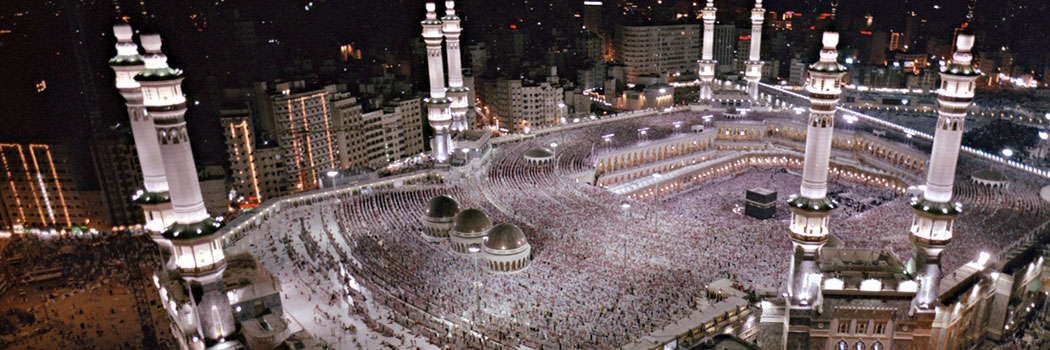Introduction
“We are committed to make this journey a great personal experience for you. A lifetime memorable journey with satisfying souls.”

Hajj or Pilgrimage to Mecca
Hajj or pilgrimage to Mecca is one of the five pillars of Islam. Hajj was made obligatory in the 9th year of Hijra. The Holy Prophet sent off 300 Muslims under the leadership of Hazrat Abubakr Siddique (may Allah be pleased with him) to Mecca so that they could perform Hajj. That was the year when it was banned for the Mushrikeen (those who associate partners with Allah) to enter Ka’ba. It was also made unlawful to perform Tawaaf (circling of Ka’ba) with naked body.
The following year, 10th Hijra, the Holy Prophet (peace be upon him) announced a head of time he himself would perform Hajj that year. He led tens of thousands of Muslims to Hajj that year and demonstrated to Muslims how to perform all the rites and rituals of the Hajj. This Hajj is known in history as Hajjatul Wida’ or Farewell Pilgrimage because this proved to be the last Hajj the Holy Prophet (peace be upon him) performed. At the end of this farewell pilgrimage, the divine revelation that had started some 22 years ago came to an end with the following verse of Surah Al-Maidah:
“This day have I completed My commandments for you, and have brought to its fullness the favor that I have bestowed upon you, and have chosen Islam as your religion.”
Hajj is an act of worship just like Salat (five daily prayers) and Sawm (fasting in the month of Ramadan). Muslims from all over the world gather in Mecca in the last month of Muslim calendar and worship Allah. Hajj is a special worship that lasts for several days. This is an occasion that brings Muslims of all countries, colors, and races to one place – the Ka’ba. This is a unique opportunity of worshipping Allah collectively in a large gathering at one place.
Three months after Ramadan comes the season of the great Pilgrimage to Makkah (Hajj), the birthplace of Islam, where an ever-increasing number of men and women converge each year, from every possible corner of the earth. The origin of the Hajj, the Fifth Pillar of Islam, dates back to the Prophet Ibrahim (AS) and brings together Muslims of all races and tongues to don two simple white cloths in an impressive display of Islam's disregard for racial or national divisions. Each year nearly several million people make the pilgrimage, making it the largest temporary gathering on the globe. It is an act of recollection and worship, but also a symbolic act representing the spirit's return to its homeland-one of the central elements of the Muslim life. Hajj is an imperative duty (fard) for all Muslims physically and financially able to perform it.
" In it are Signs Manifest; (for example), the Station of Abraham; whoever enters it attains security; Pilgrimage thereto is a duty men owe to Allah,- those who can afford the journey; but if any deny faith, Allah stands not in need of any of His creatures"
The rites begin and end at the Ka'ba the square 'House' built as Muslims believe, by Adam (AS) and restored by Ibrahim (AS) and his elder son Ismael (AS). However, the culminating moment unfolds eight miles away, where Muslims stand and pray near the Mount of Mercy, a desert place where the Prophet (pbuh) used to preach. The pilgrimage is regarded as worship of a lifetime, and in being the Final Pillar of Islam, the seal of consummation, the completion of surrender and the perfection of religion. It was during the Pilgrimage that God sent down His revelation:
"Today I have perfected your religion for you, and completed My grace upon you, and approved Islam as your religion."
Rites of the Pilgrimage God has prescribed certain rites that a pilgrim should observe properly for his pilgrimage to be accepted.
To perform the pilgrimage means to leave all worldly activities aside and to proceed to meet the Lord. The primary condition is purity of intention (niyyah). The other obligatory rites are:
1. Ihram. Before arriving in the holy city, Muslims enter a state of consecration (dedication) known as ihram, by removing their worldly clothes and donning the humble attire of pilgrims, two seamless white sheets for men, and simple white dresses and scarves for women. The white garments are symbolic of human equality and unity before God, since all the pilgrims are dressed similarly. Money and status no longer are a factor for the pilgrims - the equality of each person in the eyes of God becomes paramount. They are also expected to observe the rules of ihram, which are not to have sexual relationships, not to kill insects or animals, and not to remove any hair from the body
2. Tawaf al-qudum. Upon arriving in Makkah, pilgrims perform the initial tawaf, which is a circular, counter- clockwise procession around the Ka'ba. All the while, they state "Labbayka Allahumma Labbayk," which means, "Here I am at your service, O God, Here I am!" The tawaf is meant to awaken each Muslim's consciousness that God is the centre of their reality and the source of all meaning in life, and that each person's higher self-identity derives from being part of the community of Muslim believers, known as the ummah. Pilgrims also perform the sa'i, which is hurrying seven times between the small hills named Safa and Marwah, re-enacting the Biblical and Quranic story of Hajar's desperate search for lifegiving water and food.the Qur'an says about Safa and Marwa: "Behold! Safa and Marwa are among the Symbols of Allah. So if those who visit the House in the Season or at other times, should compass them round, it is no sin in them. And if any one obeyeth his own impulse to good,- be sure that Allah is He Who recogniseth and knowet





